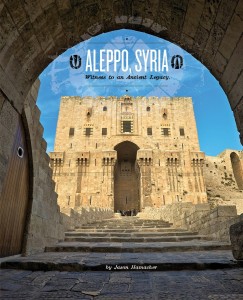 Source: The American Conservative
Source: The American Conservative
By
A friend passed on to me a must-listen Fresh Air interview with Jason Hamacher, an American punk drummer who went to Syria just before the war to record ancient Sufi and Christian liturgical music.
From the transcript:
And then two days later, the Archbishop of the United States for the Syrian Orthodox church emailed me from Teaneck, New Jersey. He was very supportive and said that he did not have the music I was looking for but had music that was similar, that was of a different practice, inside the Orthodox church.
And I asked, well, where do I get the music that I’m looking for?
And he’s like, well, what we don’t have a CD to give you.
I was like, meaning you just have one in the United States, or you don’t have one, period?
He’s like, well, we don’t have one.
I was like, you’ve been doing this 1,800 years. There’s no recording?
He’s like, no.
I was like, do you want me to make one for you?
And that was the genesis of how I started doing all of this, which snowballed into so many other things.
This explains why, when I read William Dalrymple’s great travel book From The Holy Mountain (which gave Hamacher the idea for this project), I couldn’t find online any examples of the ancient Aleppo chants he wrote about. More from the interview:
GROSS: Listening to that, it sounds almost cantorial. It reminds me of some like Jewish music – some Hebrew music.
HAMACHER: Of course.
GROSS: You say of course. Why do you say of course?
HAMACHER: Yeah. Well, of course meaning, you know, at the time when the Jews were meeting in a cave in Antioch – which was like an hour away from where I did the recording – they were Jews that believed, you know. Like they hadn’t called themselves Christians yet. Like, that happened later. And so the theory is that this is the music between the bridge, between the synagogue and the church. And there’s very striking similarities between the two.
GROSS: So are there many recordings of music from the Syrian Orthodox Church like the ancient music from the church?
HAMACHER: Yes. There’s about eight different traditions, and many of them are documented, except this one. And that is because this one tradition is only practiced in this one building on earth, and that’s the Saint George’s Cathedral in Aleppo. Inside of this tradition, there are hundreds of chants – 900. It used to be thousands. And through war and everything else over the millennia, a good portion of these have been lost and forgotten. And so I wanted to record the individuals that know everything – not just portions, but the experts – the people that know all of it. And at the time of recording, there were five. It’s now down to three. I mean, it’s kind of a metaphor to everything that’s been happening in Syria. It’s like there’s so much rich history and cultural relics that have been physically damaged by bombs, bullets, war, death. But then there are all these amazing chants that can live on.
Please listen to the whole thing, and hear this music, which has survived since the early church, but now may die as a living, continuous tradition. I am going to suggest to the choir director of our Orthodox parish when she comes back from town that if possible, she can locate music for these chants, and can learn them so we can sing them as a sign of solidarity with the persecuted Christians of the Middle East, and to keep their tradition alive.
Here’s the website for Lost Origins, Hamacher’s production company, which is dedicated to recording and preserving all kinds of ancient expressions of tradition. It will be releasing a recording later this year of the Syrian Orthodox chants. Here are a couple of examples; if you are a fan of the Dalrymple book, you will want to listen to these. First, Edessian chant. Here’s a prayer in Syriac, the ancient language of the Christian Near East. This is as close as we have to the language Jesus spoke. Click on this page to hear a Sufi chant, as well as an Assyrian Christian chant.
These sounds come to us as a message in a bottle across ages of ages. And today, as Hamacher reports, the living tradition has been scattered, for the first time in over 1,800 years, because of war. Last September, Hamacher wrote in the Washington Post:
Secretary of State John Kerry may be negotiating an end to Syria’s chemical weapons program, but the country I worked so hard to document is already gone.
Since 2006, I’ve traveled to Syria to photograph and record the nation’s ancient Christian, Muslim and Jewish communities for Smithsonian Folkways, the Sephardic Heritage Museum and the Yale Institute of Sacred Music. I have dealt with every part of Syrian society: religious leaders, Kurdish villagers, President Bashar al-Assad’s secret police, underground death-metal bands, restaurateurs, artists and professors. Today, many I know have fled. Some remain as a matter of pride, but most because they don’t have the means to escape. The archbishop who first hosted me has been abducted by terrorists. I have friends fighting on both sides, and many of the streets I spent so much time in are reduced to rubble.
Click on his Post blog to see photos of what war — that is, what men waging war with each other — have done to Aleppo’s sites, both sacred and secular.
When the Smithsonian Folkways record label releases its recordings of Hamacher’s Syrian Orthodox chants, I hope the Smithsonian, or someone, will provide musical settings of the chants so we may use them in some way in our churches.



